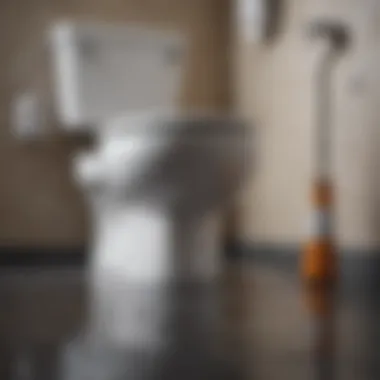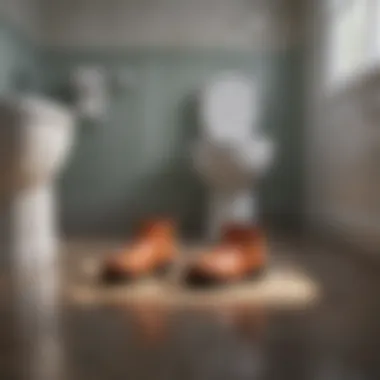Understanding the Causes of Toilet Clogs


Intro
Toilet clogs are a frequent and often underestimated issue in households. They can result in frustration and unexpected maintenance costs. Understanding the causes of these clogs is essential for any homeowner or tenant. This article will examine different factors that contribute to toilet blockages. By informing readers about common pitfalls, materials involved, and methods for prevention, a comprehensive understanding of toilet functionality can be achieved.
Toilets serve a crucial role in any living space, yet they can be vulnerable to problems caused by misuse or structural flaws. The nuances of toilet drainage and the physics behind it also play a significant role in clog formation. This exploration aims to provide insights that help mitigate such issues.
Through a detailed analysis of the causes, readers will gain practical knowledge that aids in reinforcing the longevity of their toilet systems and improves overall maintenance practices.
Feature Spotlight
Understanding the design and functionality of toilet systems is vital to recognizing why clogs occur. Toilets are architectural marvels that combine several elements to ensure proper waste management. Here, we explore some critical aspects of toilet design and how they matter.
Exceptional Architectural Designs
Toilet designs have evolved over time to enhance both performance and aesthetics. The siphonic flush system is one popular design that utilizes gravity and suction to clear waste efficiently. Additionally, modern toilets often come equipped with water-saving features. These designs, while practical, can sometimes lead to clogs due to reduced flushing power.
Unique Decor Elements
While toilets are typically not seen as decorative elements, their integration into the bathroom space has seen changes. Wall-mounted toilets, for instance, create the illusion of space and promote cleanliness. However, their installation requires precision to avoid drainage issues. Furthermore, decorative plumbing fixtures can add character but may also introduce new materials that could contribute to blockages.
"The proper design and maintenance of toilets can largely reduce the occurrence of clogs in the future."
Understanding Common Misuses
Common behaviors often lead to toilet clogs. Items such as baby wipes, feminine hygiene products, and excessive toilet paper are frequently flushed despite their inability to dissolve. Each of these commonly misused materials poses significant risks for clogging the plumbing system.
Materials That Contribute to Blockages
To explore the materials involved, it is essential to identify them accurately. Some of the most notorious culprits include:
- Toilet Paper: In excessive quantities, it can lead to blockages.
- Feminine Products: Though often marked as flushable, they do not disintegrate adequately.
- Non-flushable Wipes: Whether biodegradable or not, these wipes often cause substantial issues.
- Hair and Other Debris: Hair can easily catch and combine with other materials, increasing blockage risk.
Understanding these materials helps in making informed decisions about what should and should not be disposed of in toilets.
Preventive Maintenance Tips
Keeping toilets in good condition requires regular maintenance. Here are some strategies:
- Routine checks on plumbing fixtures to catch issues early.
- Using appropriate amounts of toilet paper for each use.
- Educating family members on what can and cannot be flushed.
- Utilizing a toilet auger to address minor clogs formed by hair or debris.
Each preventive measure not only aids in the immediate functionality of the toilet but also contributes to its long-term health.
Preamble to Toilet Clogs
Toilet clogs are a common yet frustrating issue that can disrupt daily life. Understanding the causes of these blockages is crucial, as it allows homeowners and property managers to address problems before they escalate into major plumbing disasters. The significance of this topic extends beyond mere inconvenience; it encompasses elements of hygiene, maintenance, and financial implications.
When a toilet clogs, it often results in unpleasant situations that require immediate attention. Moreover, recurring clogs can indicate underlying issues within the plumbing system that demand further investigation. By developing an understanding of toilet clogs, individuals can implement more effective preventive measures. This knowledge empowers them to make educated choices about the materials they dispose of in toilets and the maintenance practices they adopt.
Importance of Prevention
Preventing clogs not only ensures smoother daily operations but also minimizes repair costs. Once a block occurs, the repair can be costly and laborious. Therefore, a proactive approach, including knowing what substances can cause clogs and maintaining the plumbing system, is essential. Educating oneself on both common and uncommon causes can lead to better usage habits.


Benefit of Understanding Toilet Clogs
This guide will delve into various factors contributing to toilet clogs, illuminating both everyday misuse and structural issues. As toilet design varies, understanding how different models function can help users avoid mistakes. Furthermore, the article will cover essential preventive maintenance practices to assist in managing realistically one’s toilet functionality. Being informed is the first step towards a more efficient and sanitary home.
Understanding Toilet Functionality
Understanding how a toilet operates is crucial for preventing clogs and other plumbing issues. Toilets are designed with specific functions that ensure waste is effectively removed and plumbing systems are preserved. Knowledge of toilet functionality enables homeowners to identify potential issues before they escalate.
The basic understanding of a toilet system encompasses the flushing mechanics and drainage design. Each element plays a vital role, blending engineering and physics to provide an effective waste removal process. When consumers grasp this knowledge, they can take proactive measures in maintaining their toilets, thus avoiding costly repairs.
Basic Mechanics of Flushing
The flushing mechanism is often viewed as straightforward, but the inner workings are quite intricate. When the handle is pressed, it pulls a chain that lifts the flapper, allowing water from the tank to rush into the bowl. This sudden influx of water triggers a siphoning effect, which pulls waste and wastewater down the drain.
Key elements include:
- Flush valve: It controls the release of water from the tank to the bowl.
- Trapway: An integral part of the bowl that allows waste to exit without backflow.
- Water seal: Prevents sewer gases from entering the home.
Flushing relies on adequate water pressure to ensure effective waste removal. Insufficient water flow may cause remnants to remain in the bowl, leading to clogs over time.
Importance of Drainage Design
The drainage design of a toilet is not merely a convenience; it is a fundamental requirement for effective waste management. A well-designed drainage system facilitates the smooth passage of waste through the plumbing network.
Several aspects are essential in drainage design:
- Pipe diameter: Pipes that are too narrow can easily become clogged.
- Gradient: Pipes should be appropriately sloped to enable gravity to assist with waste flow.
- Ventilation: Proper venting maintains air pressure in pipes, preventing vacuums that can lead to clogs.
A poorly designed drainage system is a primary contributor to frequent toilet clogs, requiring attentive planning and execution during installation.
By understanding these principles, users can not only prevent clogs but also enhance the overall efficiency of their plumbing systems. Knowing how toilets function lays the groundwork for effective maintenance and smarter usage.
Common Causes of Toilet Clogs
Understanding the common causes of toilet clogs is essential for every homeowner. Clogs can lead to a range of issues, from inconvenient bathroom use to costly repairs. Identifying the main contributors to these blockages can empower individuals to take preventive measures. This knowledge also enhances one's ability to troubleshoot problems, reducing reliance on professional plumbing services. The overall aim is to foster an awareness of good practices in regards to toilet usage and maintenance, so these issues become less frequent.
Improper Disposal of Materials
Improper disposal of materials can seriously exacerbate clogging issues. Many everyday items that are mistakenly viewed as disposable can lead to pipe blockages. Understanding how these materials interact with plumbing systems is crucial.
Sanitary Products
Sanitary products, including pads and tampons, represent a significant cause of clogs. These items are designed to absorb moisture and expand. When disposed of in toilets, they do not break down like toilet paper. Instead, they can create blockages within the toilet and plumbing system. The key characteristic of these products is their non-degradable nature. This makes them one of the worst offenders for toilet clogs. They are a popular choice for women’s health, which emphasizes their utility but also leads to misuse in any restroom setting.
Paper Towels
Paper towels often seem like a suitable alternative to toilet paper due to their absorbency. However, their thickness is problematic. Unlike toilet paper, they do not disintegrate in water easily. The unique feature of paper towels is their durability; they last longer in water. This characteristic leads to a greater likelihood of clogs. It is advisable to dispose of these towels in waste bins rather than toilets.
Excessive Toilet Paper
Using excessive toilet paper can also lead to clogs. While many believe it is harmless, overloading bowls can overwhelm the flushing capacity of a toilet. The key feature here is the sheer volume of paper used. Excessive use can contribute to blockages, regardless of the type of toilet. If multiple flushes are required, that can further complicate the drainage process.


Foreign Objects in Toilets
Foreign objects in toilets are another major source of clogs. This section will delve into instances where everyday items inadvertently end up in the toilet.
Children's Toys
Children's toys rank among the most common culprits. Kids may accidentally drop them into the toilet during play, leading to unexpected blockages. These toys are not designed to disintegrate, making their removal challenging once they are lodged in the plumbing system. Their key characteristic is that they vary in shape and size, which makes it difficult for water to push them through the pipes. While they provide entertainment for children, they pose significant problems when misused in bathrooms.
Other Non-Decomposable Items
Other non-decomposable items, such as items made from plastic or certain types of wrappers, can also lead to clogging issues. These materials do not break down after flushing. The unique feature of these items is their durability and resistance to breaking apart. This quality is beneficial in their primary uses but detrimental to plumbing. It is critical to educate households on appropriate disposal methods to prevent these blockages.
Plumbing Issues
Lastly, plumbing issues form a category of causes behind toilet clogs. While improper disposal is often to blame, structural problems in the plumbing system can greatly contribute.
Tree Root Intrusion
Tree root intrusion can cause severe drainage issues. Roots will seek out moisture, and if they infiltrate a sewer line, they can lead to significant blockages. The key characteristic of tree roots is their growth ability. Over time, they may expand and constrict the pipes further. Ignoring these roots can lead to serious plumbing failures. The advantages of identifying this issue early include saving costs on repairs and preserving home plumbing integrity.
Corroded Pipes
Corroded pipes are a common issue in older plumbing systems. When pipes corrode, their internal diameter shrinks, making it difficult for waste to pass through. This key characteristic of aged pipes often leads to increased resistance against water flow. Recognizing the signs of corrosion can prompt timely remedial action, preventing major clogs or bursts.
Improper Pipe Slopes
Improper pipe slopes refer to the angle of drainage pipes that can impede fluid flow. A slope that is either too steep or not steep enough can lead to waste settling in pipes, resulting in clogged systems. The unique feature of pipe slope is that it is often ignored during installation, leading to future problems. Identifying and correcting these angles can dramatically improve drainage efficiency.
"Regular maintenance and awareness of what should and should not be flushed can greatly reduce the risk of clogs."
The Role of Toilet Maintenance
Toilet maintenance plays a critical role in preventing clogs and ensuring the efficient functioning of plumbing systems. Regular care can substantially prolong the lifespan of toilets, lower repair costs, and promote hygiene in any residential or commercial setting. Without maintenance, small issues can escalate quickly into major problems, leading to costly repairs or even necessitating the replacement of the entire toilet.
Key elements of toilet maintenance include
- Regular inspections to identify potential issues before they become significant problems.
- Proper use of cleaning agents to keep toilets functioning at peak efficiency.
These practices not only assist in identifying wear and tear but also help in understanding how to mitigate future issues, making it a worthwhile investment in any property owner's long-term strategy.
Regular Inspection Practices
Inspection of toilets should occur regularly. A simple check can reveal signs of leaks, loose parts, or other mechanical issues. Key areas to assess include:
- The flush mechanism, to ensure it operates smoothly.
- The trapway, where blockages often form due to buildup.
- The water supply line, for leaks or corrosion that may lead to bigger plumbing concerns.
Moreover, examining the condition of the toilet seal can reveal if there is potential for external leaks. Noticing these issues early can greatly reduce the severity of damage and avoid emergency repairs. Keeping a log of inspections will provide valuable insights over time and may highlight patterns in wear and tear.
Use of Drain Cleaners
Utilizing commercial drain cleaners can aid in the maintenance of toilets. However, one must proceed with caution. Not all cleaners are suitable for toilet use. It's essential to choose products that are specifically designed for toilet systems. Common ingredients to avoid in drain cleaners include harsh acids that can damage components.


Effective application involves:
- Following the manufacturer's instructions for optimal results.
- Avoiding overuse as it may lead to pipe damage or malfunction.
Regular use of gentle, enzymatic drain cleaners can prevent buildup and maintain a healthy drain system without the risk of harmful effects. Additionally, these products often offer a proactive approach to unclogging potential issues before they escalate.
Considerations for Aging Toilets
The importance of addressing considerations for aging toilets lies in their impact on plumbing efficiency and overall household maintenance. As toilets age, wear and tear become inevitable, leading to various issues including clogs, leaks, and diminished functionality. Understanding the nuances of an aging toilet can lead to substantial savings in repair costs and can enhance the overall usability of your bathroom fixtures.
Identifying Wear and Tear
Identifying wear and tear involves a methodical examination of the toilet's components. Homeowners should look for signs such as:
- Cracks in the porcelain
- Signs of rust or corrosion around metal parts
- Frequent clogging or slow drainage
- Water pooling around the base
Regular checks can reveal problems early. These issues may not only disrupt daily life but can escalate quickly if left unresolved. Catching these signs early can save both money and prevent more significant plumbing disasters in the future.
Replacement vs. Repair
When faced with the decision to repair or replace an aging toilet, several factors need consideration. It is critical to complete a cost-benefit analysis. Here are some key elements to ponder:
- Cost of repairs versus replacement: Sometimes repairing can be a temporary fix that may not address underlying issues, especially if they are extensive.
- Toilet age: If the toilet is nearing its lifespan, generally around 20-30 years, replacement may be more logical. Older models can often lead to increased water bills due to inefficient flushing.
- Upgrades: Newer toilets often have improved efficiency and perform better than older ones. Consider if your toilet can be upgraded to a low-flow model, which not only is environmentally friendly, but can also save substantially on water bills.
"Regular maintenance of aging toilets can unveil potential issues before they become problematic."
Concluding whether to repair or replace requires evaluating both emotional and financial implications. The ongoing maintenance of a toilet is just as essential as selecting its initial installation. Taking these considerations into account will ensure more effective, long-lasting plumbing solutions.
Beyond Clogs: Related Plumbing Concerns
Understanding plumbing issues that extend beyond toilet clogs is crucial for maintaining a healthy and functional household plumbing system. Problems such as backflow and low water pressure can have significant implications for overall plumbing functionality and can be indicators of more severe issues. Addressing these concerns promptly can save homeowners time and money in the long run. Furthermore, being aware of related plumbing concerns allows for more informed decisions regarding maintenance and repairs.
Backflow Issues
Backflow is a situation where wastewater flows back into clean water supply lines due to a change in pressure. This condition could occur suddenly, causing contaminants to enter potable water systems, leading to serious health hazards. Typically, backflow can happen for a variety of reasons, including:
- Back Pressure: This occurs when the pressure in the drainage system exceeds that of the water supply, causing water to reverse direction.
- Back Siphonage: Often caused by suddenly reducing the water pressure in the supply line, which pulls wastewater back into the system.
Preventing backflow is essential. Installing a backflow prevention device can mitigate risks significantly. Regular inspections of these devices can ensure they function correctly, ultimately safeguarding your family’s health and the integrity of your plumbing system.
"Backflow prevention devices are critical to maintaining safe drinking water in your home."
Low Water Pressure
Low water pressure can stem from multiple factors, often relating to damages in the plumbing infrastructure. It can be a frustrating situation, particularly when it affects the functionality of not only toilets but also sinks, showers, and appliances. Some common reasons for low water pressure include:
- Clogged Plumbing: Over time, mineral deposits and debris can build up in pipes, leading to restricted water flow.
- Leaking Pipes: Any leaks can cause a drop in water pressure as they result in water escaping before it reaches its destination.
- Municipal Supply Issues: Sometimes, low pressure issues may originate from the local water supplier, impacting the flow throughout neighborhoods.
Detecting and addressing low water pressure involves regular monitoring of water flow rates. Homeowners should consider checking aerators and showerheads for buildup and be vigilant about potential leaks in their systems. Knowing how to manage low water pressure can enhance not only convenience but also efficiency within the home.
Closure
In reviewing the complexities behind toilet clogs, it is vital to understand the multi-faceted nature of this issue. The conclusion is more than just a summary; it synthesizes the key points discussed throughout the article, offering readers a holistic view of both the immediate and long-term implications of toilet maintenance and usage.
Toilet clogs can result from a variety of factors ranging from improper disposal of materials to structural plumbing issues. These causes highlight the importance of both personal responsibility and awareness in maintaining a fully functioning system. When individuals recognize what should and should not go into toilets, many clogs can be prevented.
Moreover, regular inspection practices and understanding the aging of toilets play crucial roles in the longevity of plumbing systems. Often, inhabitants may overlook subtle signs of wear that, if identified early, could save significant costs down the line. This vigilance ensures not only the functionality of a toilet but also the overall health of the plumbing in a home.
The conversation does not end once one learns about clogs. Instead, it is a stepping stone to greater insights into home maintenance. Recognizing potential backflow issues or low water pressure becomes part of a broader understanding of plumbing health. In this way, readers are encouraged to stay informed and proactive, turning knowledge into action.







